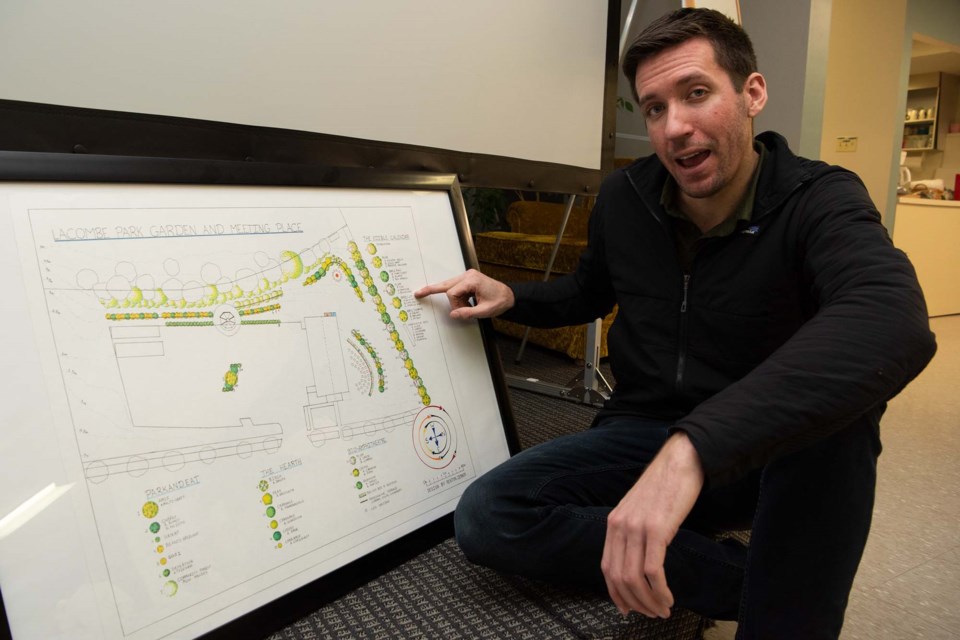Lacombe food forest
Lacombe Park residents will soon have a fruit calendar and drive-by eating as part of a proposed new community garden.
About 15 people were at Grace Family Church in St. Albert Feb. 17 to see permaculture designer Kenton Zerbin unveil the design of the Lacombe Park Community Garden.
Church pastor Mike McElroy proposed this project as a way to bring the community together, said Elwira Rosiak, a member of the garden’s organizing committee. The committee teamed up with Zerbin to come up with a plan and snagged a $5,190 Environmental Initiative Grant from the city to help fund it.
Zerbin said this garden would become a space where people can grow food and meet as a community.
“A lot of times people have fruit trees and they don’t eat all the fruit on it,” he said, resulting in wasted food.
“Why would you have an apple tree in your backyard instead of having six apple trees in your local park?”
Zerbin said he designed this garden to fit the light, water, wind, and foot-traffic conditions around the Grace Family Church.
The parking lot will feature a long row of fruit trees and shrubs along its west edge and a tree that grows six different types of apple planted on its centre island, Zerbin said. These plants will reduce the lot’s drainage problems, let visitors tell at a glance (via the six-fruit tree) what’s ripe elsewhere in the garden, and offer a “drive-by-eating” experience.
“You could drive your car along the parking lot and actually pick haskap berries out your window,” he said, adding that he encouraged people to park-and-pick instead.
The north side will feature a long row of tall apple, plum, apricot, and pear trees, Zerbin said. These will be organized based on fruit-maturity date to create an “edible calendar.”
“It’s going to be a lot of food,” Zerbin said of this region.
The design also features a bio-amphitheatre with log seats with garden beds behind them, and a hearth area with a fire pit for relaxation. On-site composters and rainwater collectors would provide garden resources.
Zerbin said he was excited by this chance to show people how they can have a net positive impact on the environment.
“What I love is that it’s a community-built space for the community.”
Zerbin said the plan was to have volunteers build this garden through a series of blitz events, the first of which would be April 25 to correspond with the Edmonton Permaculture Guild’s Resilience Festival.
Rosiak said the garden committee was seeking volunteers to help with the blitz as well as donations of logs and edible plants. Email [email protected] for details.
Yellowknife wheat?
Global heating could make Yellowknife a good place to grow wheat, a recent study suggests, but doing so could come at great environmental cost.
University of Guelph geography professor Krishna K.C. co-authored a study Feb. 12 in PLOS ONE on the environmental consequences of climate-driven agricultural frontiers.
K.C. said he and his team wanted to find out how projected changes in rainfall and temperature from global heating would affect where people could grow crops such as wheat and potatoes by the end of this century, and the consequences of expanding agriculture into these new areas.
The team found that under a business-as-usual scenario for greenhouse gas emissions, the world would see harvestable land grow about 30 per cent, much of which would be in Russia and Canada, due to global heating.
“In the Canadian context, we could grow even more,” he noted, with up to 4.2 million square kilometres more land becoming suitable for wheat and potatoes by the end of this century – about four times the area we have today.
“It’s a huge number.”
The study found large swaths of the northern Prairies and the Northwest Territories would become suitable for wheat and potato production by 2070. K.C. cautioned that this was the upper limit of what was possible, as the study did not account for soil or sunlight conditions in these new areas and did not address how warming could make current wheat/potato areas less suitable for those crops.
Actually farming all this new land would have serious consequences, he continued. Plowing these new areas could release up to 177 gigatonnes of carbon (equivalent to 119 years of current American CO2 emissions), threaten more than half the world’s biodiversity hotspots, and have serious water quality impacts on some 1.8 billion people.
“We need food but we don’t want environmental impacts,” K.C. said.
“We need to find a way to balance.”
K.C. said places like Alberta should promote soil-preserving agriculture (e.g. no-till farming) and create policies – perhaps even a carbon tax – to encourage farming on degraded pastures instead of these carbon-rich new areas. Alberta would also have to work with Indigenous communities in these regions to see if they even wanted to convert these lands to farms.
The study can be found at bit.ly/38EyLmP.




